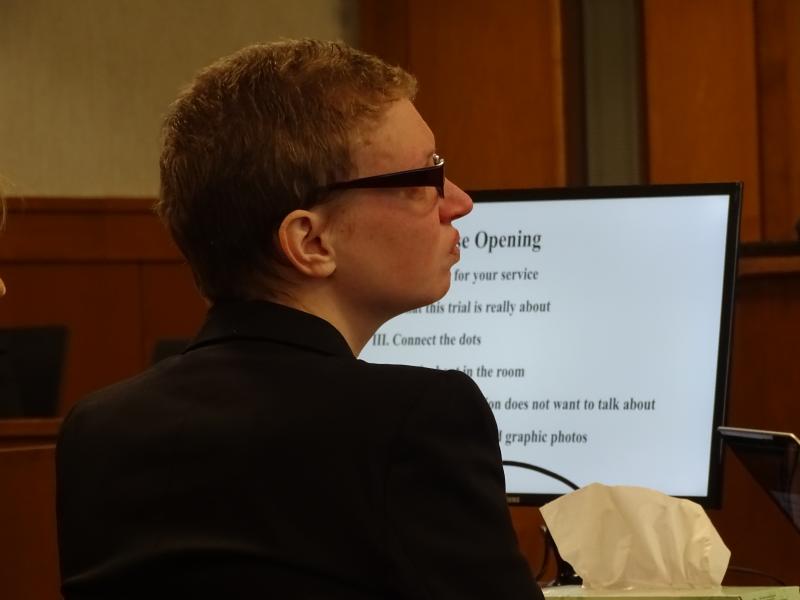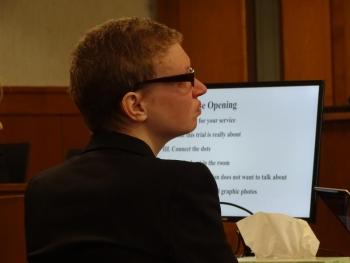Chief Medical Examiner walks Carrillo jury through Marissa Kennedy autopsy findings
BELFAST — During the second half of day four of the trial against Sharon Carrillo, more images were displayed for jurors and spectators. With Maine State Police Computer Crimes Forensic Analyst Dawn Ego still on the stand, over a dozen photos depicting home documentation of Marissa’s injuries recovered from cameras in the Carrillo household were shown.
Dec. 11 was the fourth day in the trial of Sharon Carrillo, who, along with her then-husband Julio Carrillo were both arrested and charged with depraved indifference murder in the death of Sharon’s then-10-year-old daughter Marissa Kennedy. Julio Carrillo pleaded guilty to his charge in July and was sentenced to 55 years in prison.
While most of the photos were displayed on the big screen in the courtroom, some were shown only to jurors by handing a photo around. Some jurors looked at the pictures for several seconds while others only glanced before handing them on. One juror wiped tears from his eyes. Several individuals cried at varying points of the photo and video displays.
The photos displayed were some of the 6,500 taken from the nine total phones taken from the Carrillos and those found in the Carrillo home by Sharon’s father and turned over to her defense team, who turned them over to Maine State Police.
A number of videos were also played for jurors. In one, Sharon is sitting back to the camera on the edge of the largest bed in the bedroom the family shared as Julio narrates.
“Since 8 this morning she has been at it again has been screaming, one 16 months old, one…. Sharon Carrillo needs to be put away for a long time and lost custody of all her kids…. I hope that she loses all her kids, thanks for listening.”
In another video, Sharon is shown sitting on the floor with her son while Julio tells her to “get your butt off the floor now and be a mother.” The video ends with Sharon crawling away on her hands and knees telling Julio to “get away” from her.
Marissa is also seen in several of the videos, pleading with Julio to stop recording her with the camera.
Over 17 photographs recovered from the nine cell phones examined were shown to jurors, with most showing Marissa’s injuries.
Some of the injuries shown in the images include scratches on the arm, Marissa sitting nude in a chair with a black eye and bruises of various shades of purple all over her body. A close-up picture captures the extreme and extensive bruising on Marissa’s legs and hip. Most of the images documenting Marissa’s extensive and horrific injuries were taken Feb. 24, one day before her death.
Maine State Chief Medical Examiner Dr. Mark Flomenbaum testified Dec. 11 about injuries sustained by Marissa.
Flomenbaum said he has performed between 2,000-3,000 autopsies over his career, and said Marissa Kennedy’s cause of death was battered child syndrome.
When Marissa first arrived at the Office of the Chief Medical Examiner, Flomenbaum determined that Marissa likely died just hours before arriving at the facility.
Before going over the pictures of Marissa’s beaten body, Flomenbaum explained to jurors the three types of blunt force trauma: contusions, lacerations, and abrasions. A contusion, he explained, is the medical term for a bruise, which means someone was struck hard enough not to rupture the skin, but to cause bleeding underneath. Flomenbaum said the fresher a bruise is, it will appear red or purple and have very well defined edges; as the bruise ages it changes color and the borders become faint.
A laceration occurs when a blunt force impact is either hard enough or on a particular area that causes the skin to rip open, according to Flomenbaum. An abrasion, he said, is basically a scrape, which is a blunt force impact with “some directionality.” The term hemorrhage is the medical term for bleeding and is used anytime blood is found outside of the area where it belongs.
The autopsy photos of Marissa showed injuries from head to toe, covering much of her body.
Flomenbaum discussed the mode of injuries, noted bruising, lacerations the size of golf balls, internal bleeding in the brain, in her liver, and heart damage due to chronic stress. Marissa had also apparently suffered broken ribs that had started to heal.
Flomenbaum said that while the brain or liver bleeding could have been fatal if not treated, it was something that could be remedied by a doctor.
“She need not have died because of that injury,” Flomenbaum said of Marissa’s bleeding on the brain. “But it had the potential of getting worse without treatment and could have become fatal.”
Flomenbaum discussed several other injuries to the 10 year old girl, caused by severe physical abuse. He said she suffered infection from her injuries.
He counted between 40 and 50 blunt force trauma injuries, including contusions, lacerations and abrasions, on Marissa’s body.
In addition to the pain and trauma left behind by the beatings, Marissa was also dealing with her own body’s response to all the pain it was put through day in and day out.
Flomenbaum said that every time pain occurs, the body responds with adrenaline, often called the fight or flight instinct. Flomenbaum said that leads to an increased heart rate.
Flomenbaum said that the same surge of energy comes every time pain occurs, though he noted that the fear of being injured can also cause the same surge of energy. Usually, the surge of energy dissipates and the body returns to a normal state after the danger or pain has passed. When the danger and pain never goes away, however, organs begin to suffer.
For Marissa, a feeling of fight or flight was almost constant, between multiple daily beatings and the ever-present specter of more abuse. Flomenbaum said that when the feeling of flight or flight becomes constant, repeating over and over, adrenaline will damage organs, including the heart and thymus.
The thymus is a gland Flomenbaum said is predominant in babies and newborns, and it is active in youth. This is relevant, Flomenbaum said, because when an adrenaline surge begins, an active thymus it will release t-lymphocytes. Usually, this isn’t problematic because the body replenishes its supply by the next time an adrenaline surge is needed, but for those subjected to chronic stress, like Marissa, the body has no chance to replenish those t-lymphocytes.
Eventually, this leads to thymic-involution, which is the shrinking of the thymus. Flomenbaum said that Marissa’s thymic involution was dramatic, and serves as one important marker in chronic stress. Flomenbaum also said it can affect an individual’s ability to fight infection.
“In Marissa’s case I’m thinking it’s her heart that ultimately gave way,” he said.
Flomenbaum said that when a person has a fight or flight response, it causes the heart to beat harder and faster, which is exactly what it’s supposed to do. When an “enormously large” dose of that adrenaline is released, Flomenbaum said the heart just can’t keep it there.
“What we see is a heart cell here and there that [have] died, which he said is not the same thing as a heart attack where the heart is starved,” he said.
According to Flomenbaum, in cases of adrenaline exposure death the cells look foamy. Flomenbaum said even most adults rarely have those types of cells.
“Marissa had a lot of them; they were easy to find,” Flomenbaum said. “There were also very recent cells that showed [her] heart was contracting way too hard, the heart that just couldn’t keep up.”
Flomenbaum said that it was an accumulation of injuries that killed Marissa.
“[Marissa’s] heart finally gave way because of the constant stresses it had due to the pain, the inability to fight the infection, due to the bleeding on the brain, each one of those independently would be survivable, but cumulatively not so,” Flomenbaum said.
The trial of Sharon Carrillo will continue tomorrow at 9 a.m.
Erica Thoms can be reached at news@penbaypilot.com
Event Date
Address
United States




























